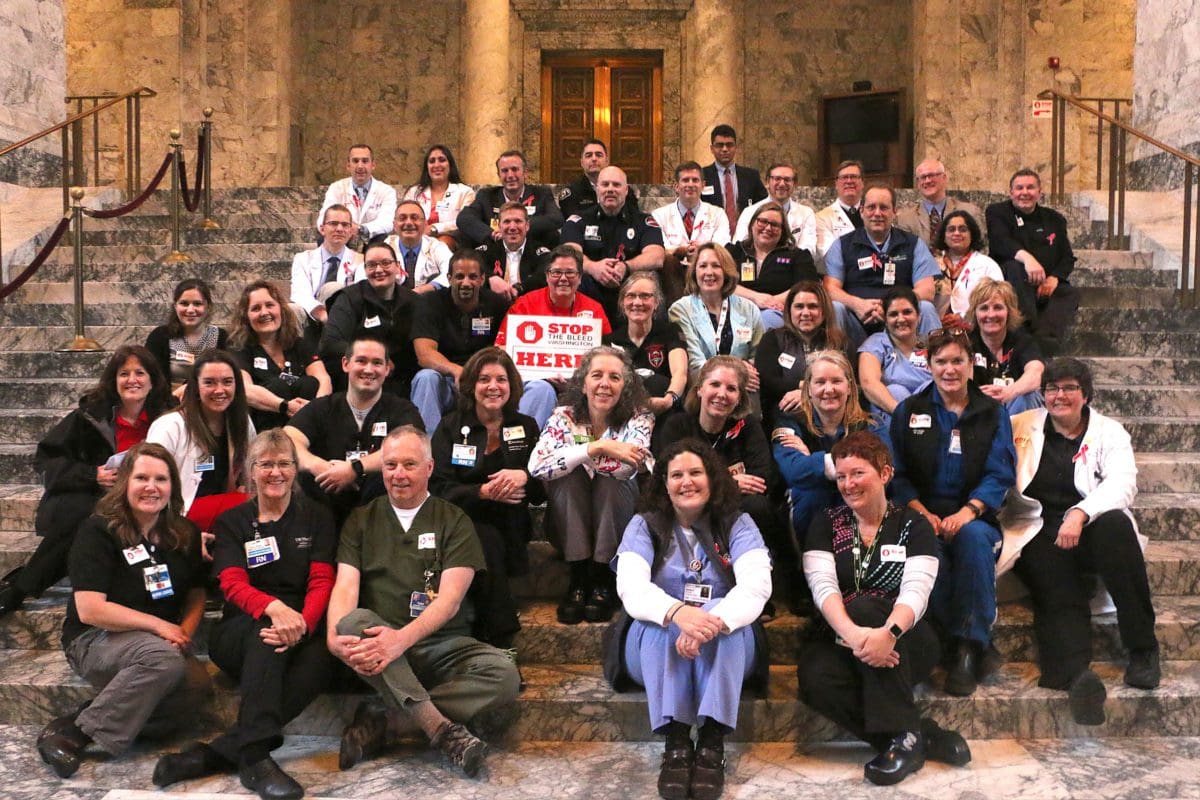
A person who is bleeding can die from blood loss within five minutes. Blood loss is the leading cause of preventable death in multiple casualty events, like mass shootings, terrorist attacks and earthquakes. Significant external bleeding can also result from everyday events such as a motorcycle crash, or industrial accident. Emergency responders will arrive as quickly as possible, but bystanders are almost always there first. Rapid control of bleeding at the scene of the event can be life-saving. In the case of disaster and high casualty incidents, emergency services are often spread thin. Will you be ready?
Thank you for your interest in helping us Stop the Bleed. With three quick actions, you can be trained to save a life. The number one cause of preventable death after injury is bleeding. That’s why we want to train you how to STOP THE BLEED®.
There is a new online, interactive course available at www.stopthebleed.org
The STOP THE BLEED® Interactive Course guides you through the three methods of bleeding control using video demonstrations, interactive learning, and spontaneous quizzes. The site offers resources, as well as equipment for purchase.
For questions about the Stop the Bleed program go to the website www.stopthebleed.org or contact Maria Paulsen, RN, Program Manager, Trauma Outreach Education at Harborview Medical Center
Phone: (206) 744-5435
Email: mruoff@uw.edu
Everyone! Learning to control bleeding is an essential skill that anyone can apply to save lives, just like CPR. In particular, these skills are important for non-tactical law enforcement, firefighters, security personnel, emergency coordinators and teachers. In addition, we recommend that all workplaces have multiple employees trained in bleeding control.
Individuals with medical experience such as EMTs, paramedics, nurses, nurse practitioners, physicians, physician assistants, medical students, nursing students and athletic trainers can teach this course. To learn more, visit www.stopthebleed.org
Video presented by The Hartford Consensus.
In recognition of the growing threat of mass casualty events and the need for enhanced training of bystanders to manage life threatening bleeding in these situations, we encourage the installation of bleeding control kits in public buildings in King County where large numbers of people gather. These kits will provide the tools to allow immediate management of life-threatening hemorrhage until EMS providers can arrive. Events such as the Boston Marathon bombings and recent mass shootings highlight the need for increased availability of effective, commercial tourniquets as improvised tourniquets are often ineffective and can make bleeding worse if arterial inflow is not occluded.
A bleeding control kit contains the essential medical equipment and supplies required to save a life in the event of immediate, life threatening bleeding. A kit can be designed for a personal or home situation or for a larger more public venue.
Each kit should contain these basic items:
Public access kits should contain supplies to treat at least 8 casualties, they may also include specialized packing materials that have been treated to accelerate the clotting process to stop hemorrhage as quickly as possible. They may also include some devices to help move patients in an emergency situation.
Large multi-person commercial bleeding control kits should be mounted in all public access areas including but not limited to those listed below:
Bleeding control kits should be mounted right next to all existing Automatic Defibrillators (AED)
A personal or smaller kit can be kept in or along with your emergency or disaster supply bag or kit, in your car, with your camping gear, etc.
Everyone should learn Stop the Bleed skills.
Uncontrolled bleeding injuries can result from natural and manmade disasters and from everyday accidents, as well as from catastrophic and terrorist incidents. If this bleeding is severe, it can kill within minutes, potentially before trained responders can arrive. Bystanders who have been provided with basic tools and information on the simple steps they can take in an emergency situation to stop life threatening bleeding can save lives.
Research has shown that bystanders, with little or no medical training, can become heroic lifesavers. Similar to the use of CPR or automatic defibrillators, improving public awareness about how to stop severe bleeding and expanding personal and public access to bleeding control kits can be the difference between life and death for an injured person.
There are several commercial kits available online, including an online bleeding control store by the American College of Surgeons. We do not otherwise endorse any specific company, but a quick internet search for bleeding control kits, hemorrhage control kits, or tourniquets will yield several companies that can supply you with either pre-made kits and supplies or individual products so you can assemble your own kit.
You can purchase a premade/prestocked kit or you can purchase the items individually and put together your own kit.
When purchasing your own individual tourniquets, we would recommend either the CAT (Combat Application Tourniquet) or the SOFT-T Wide (Special Operations Forces Tactical Tourniquet Wide).
SOF® Tactical Tourniquet Wide (Special Operations Forces Tactical Tourniquet)
CAT® (Combat Application Tourniquet)
Improvised tourniquets are rarely as effective as commercially manufactured tourniquets, because they cannot be tight enough to actually stop the bleeding, especially in arterial injuries. As a matter of fact, often these improvised tourniquets can make the bleeding worse by prevention venous return.
Belts cannot be tightened enough, rope or string is too thin to actually stop arterial bleeding and will cause more tissue damage.
When purchasing your own individual tourniquets, we would recommend either the CAT (Combat Application Tourniquet) or the SOFT-T Wide (Special Operations Forces Tactical Tourniquet Wide).
SOF® Tactical Tourniquet Wide (Special Operations Forces Tactical Tourniquet)
CAT® (Combat Application Tourniquet)
‘A Perfect Stranger’ tells the story of Kinneil and Angelia and the event that brought the two women together. When a motorcycle accident left a frightened Angelia on the street alone and bleeding, Kinneil didn’t just stand by, she cared enough to stop and provide a comforting hand and a reassuring voice. Learn more at www.ready.gov/prepare.
Video produced by King County EMS in collaboration with the King County Sheriff.
Video produced by King County EMS in collaboration with the King County Sheriff.
In 2013, following the the active shooter disaster on December 14, 2012, at Sandy Hook Elementary School in Newtown, CT, the Joint Committee to Create a National Policy to Enhance Survivability from Intentional Mass Casualty and Active Shooter Events was convened by the American College of Surgeons (ACS) in collaboration with the medical community and representatives from the federal government, the National Security Council, the U.S. military, the Federal Bureau of Investigation, and governmental and nongovernmental emergency medical response organizations, among others. The committee was formed under the guidance and leadership of Trauma Surgeon Lenworth M. Jacobs, Jr., MD, MPH, FACS, vice president of academic affairs and chief academic officer at Hartford Hospital, and professor of surgery, University of Connecticut School of Medicine, to create a protocol for national policy to enhance survivability from active shooter and intentional mass casualty events. The committee’s recommendations are called the Hartford Consensus, and currently consist of four reports.
American College of Surgeons Committee on Trauma
This report describes the development of an evidence-based guideline for external hemorrhage control in the prehospital setting. This project included a systematic review of the literature regarding the use of tourniquets and hemostatic agents for management of life-threatening extremity and junctional hemorrhage. Using the GRADE methodology to define the key clinical questions, an expert panel then reviewed the results of the literature review, established the quality of the evidence and made recommendations for EMS care. A clinical care guideline is proposed for adoption by EMS systems.
More than 40 first-responders, nurses, physicians, surgeons and staff came together for Stop the Bleed Washington Legislative Day in Olympia, Washington on Jan. 10, 2018.
Together we trained an estimated 388 legislators, staff and visitors in basic tourniquet and wound-packing techniques, as well as met with legislators to raise awareness of Stop the Bleed and the need for bleeding control kits in public areas.
